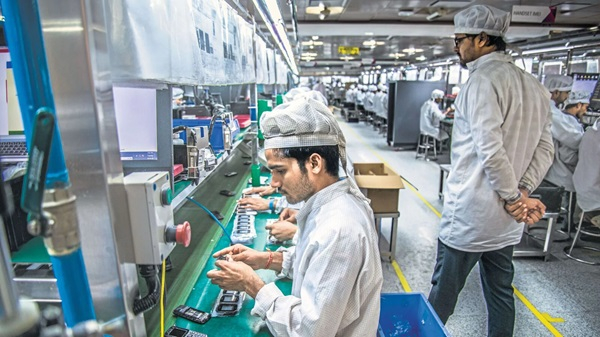Budget 2024: Electronics Industry Calls for Duty Cuts and Incentives
- by B2B Desk 2024-07-10 07:11:43
Ahead of the 2024 Union Budget, handset and electronics makers are pushing for simpler import duties and gradual reductions on mobile phone components. They aim to attract global supply chains to India and foster large-scale manufacturing.
The Indian Cellular and Electronics Association (ICEA) stated that these changes would enhance competitiveness, scale, and exports from India, allowing it to better compete with China and Vietnam, which currently benefit from lower and simpler input duty structures. They anticipate that reducing tariffs across different categories will bring India on par with Chinese and Vietnamese levels by FY 2026-27.
The handset and electronics manufacturers, represented by ICEA, have also requested incentives totaling Rs 40,000-45,000 crore. These incentives could be provided as direct financial support or through the production-linked incentive (PLI) scheme, aimed at boosting local manufacturing of mobile phone components.
The ICEA has presented their request to the finance ministry, expecting it to be addressed in the upcoming Union Budget.
Representing companies such as Apple, Foxconn, Dixon, Xiaomi, Lava, and various other Indian and multinational electronics and handset manufacturers, the body also urges the government to offer suitable policy and financial backing for establishing extensive component and sub-assembly ecosystems, accommodating longer gestation and incentive periods.
The body emphasized that India's current tariff structure is overly intricate with multiple slabs, advocating for simplification to just three: 0%, 5%, and 10% by 2025 across different component categories.
According to the statement, this initiative will strengthen India's component ecosystem and attract global value chains (GVCs), positioning the country to compete effectively with China and Vietnam. The objective is to significantly increase electronics manufacturing and exports over the next five years.
ICEA is urging the government to lower the basic customs duties on chargers, adapters, and printed circuit board assembly (PCBA) from 20% to 15%.
ICEA suggested that the duty on parts of PCBA, camera modules, and connectors should be reduced to zero.
According to ICEA's findings from their tariff comparison report across China, India, Vietnam, Thailand, and Mexico, the current high tariffs in India increase manufacturing costs by 7.0-7.5% on the bill of materials. This hinders the development of a local ecosystem, reduces export competitiveness, and negatively impacts job creation.
ICEA's latest report highlighted that India imposes a simple average MFN (most favored nation) tariff of 7.4% on inputs. In contrast, China maintains zero tariffs in bonded zones, and Vietnam's FTA-weighted average tariff stands at 0.7%.
According to the study analyzing data from eight tariff lines, India has significantly more components subjected to higher duty slabs compared to other countries. Vietnam, for instance, has 97% of its weighted average tariffs between zero and 5%, whereas 56% of China's tariff lines fall within that range.
Pankaj Mohindroo, Chairman of ICEA, emphasized that sustaining the rapid growth in mobile phone production and exports hinges on aligning India's tariff regimes with the competitive levels seen in China and Vietnam. High tariffs, which currently increase manufacturing costs in India by 7-7.5% on the bill of materials (BoM), hinder the development of the local ecosystem, impede exports, and negatively impact job creation.
He pointed out that high tariffs on inputs diminish export competitiveness by making products less attractive, ultimately reducing overall production, particularly of final products like mobile phones. Mohindroo stressed the urgent need for reducing tariffs on inputs to address these challenges effectively.
Mohindroo explained that the financial support package, spanning eight years, is intended for components and sub-assemblies. He noted that this initiative will coincide with the mobile PLI scheme, which will have a sunset date.
ICEA underscored in its report that electronics manufacturing has emerged as a crucial sector for economic growth and job creation in India. To progress significantly through exports, India must transform into a globally competitive manufacturing and export hub. The focus should be on attracting global value chains (GVCs) and fostering the growth of large-scale Indian companies. These companies need to establish extensive factories and warehouses on a global scale to ensure timely delivery, the report emphasized.
According to a study by ICEA, India maintains the highest tariffs on materials compared to competing economies like China and Vietnam. These high tariffs result in increased costs for Indian industries, reducing their competitiveness and making it difficult for them to integrate into Global Value Chains (GVCs). This situation also discourages GVCs from shifting operations to India.
ICEA emphasizes that competitiveness is crucial for India to achieve scale and attract Foreign Direct Investment (FDI), which in turn boosts domestic value addition and creates jobs. The study suggests that reducing these tariffs would not only lead to lower government revenues initially but would be offset by increased affordability, higher production, greater smartphone sales, and overall economic growth driven by job creation.
ICEA conducted a comprehensive study on tariffs across seven competitive economies, including India, forming the basis for its recommendations. In its latest report, ICEA emphasized the importance of developing a robust domestic supply chain but argued against using high tariffs for protection. Instead, ICEA advocated for enhancing competitiveness and introducing incentive schemes to address existing gaps.
To attract Global Value Chains (GVCs) and stimulate production scale, ICEA proposed reducing tariffs to zero on all components, including those in complex subassemblies. Specifically, ICEA suggested eliminating the 2.5 percent tariff on sub-assembly parts and inputs.
ICEA criticized these tariffs as ineffective in fostering a domestic industry while unnecessarily raising costs, complexity, and compliance burdens for legitimate manufacturers.
In the fiscal year 2023-24, India achieved a significant milestone in electronics manufacturing, recording a historic output of $115 billion, with exports totaling $29.1 billion. This places electronics as India's fifth-largest export category. The mobile phone segment alone contributed a substantial 54 percent to these exports, amounting to $51 billion in production value. Over the past decade, mobile phone production has surged by 21 times, while exports have skyrocketed by 81 times, drastically reducing import dependence from 78 percent in 2014-15 to less than 3 percent in FY23-24.
Today, the growth in mobile phone production is primarily driven by exports, highlighting India's expanding role in global markets.
Looking ahead, industry leaders like Mohindroo emphasize the goal of accelerating India's electronics manufacturing to even greater heights. They advocate for focused policies, robust financial support, competitive tax structures, and the development of advanced skills. This strategic approach aims to position India as a leader in the global electronics industry, leveraging innovation, self-reliance, and proactive planning to shape a promising future.
Also Read: XIRR in Mutual Funds: Understanding Its Meaning and Importance
POPULAR POSTS
Loan EMIs to Drop as RBI Slashes Repo Rate - Full MPC December 2025 Highlights
by Shan, 2025-12-05 11:49:44
Zoho Mail vs Gmail (2025): Which Email Platform Is Best for Businesses, Startups, and Students?
by Shan, 2025-10-09 12:17:26
PM Modi Launches GST Bachat Utsav: Lower Taxes, More Savings for Every Indian Household
by Shan, 2025-09-24 12:20:59
$100K H-1B Visa Fee Explained: Trump’s New Rule, Clarifications & Impact on Indian Tech Workers
by Shan, 2025-09-22 10:11:03
India-US Trade Deal Soon? Chief US Negotiator Arrives in Delhi as Talks Set to Begin Tomorrow
by Shan, 2025-09-15 11:54:28
Modi Meets Xi: Trump’s Tariffs, Strategic Autonomy, and the Future of Asia’s Power Balance
by Shan, 2025-09-03 06:40:06
Google Claims Gemini AI Uses Just ‘Five Drops of Water’ Per Prompt, Sparks Debate
by Shan, 2025-08-22 12:34:27
RECENTLY PUBLISHED

Pine Labs IPO 2025: Listing Date, Grey Market Premium, and Expert Outlook
- by Shan, 2025-11-05 09:57:07

The Agentic Revolution: Why Salesforce Is Betting Its Future on AI Agents
- by Shan, 2025-11-05 10:29:23

Top 10 Insurance Companies in India 2026: Life, Health, and General Insurance Leaders Explained
- by Shan, 2025-10-30 10:06:42

OpenAI Offers ChatGPT Go Free in India: What’s Behind This Big AI Giveaway?
- by Shan, 2025-10-28 12:19:11

Best Silver Investment Platforms for 2025: From CFDs to Digital Vaults Explained
- by Shan, 2025-10-23 12:22:46





 Subscribe now
Subscribe now 